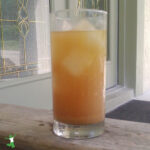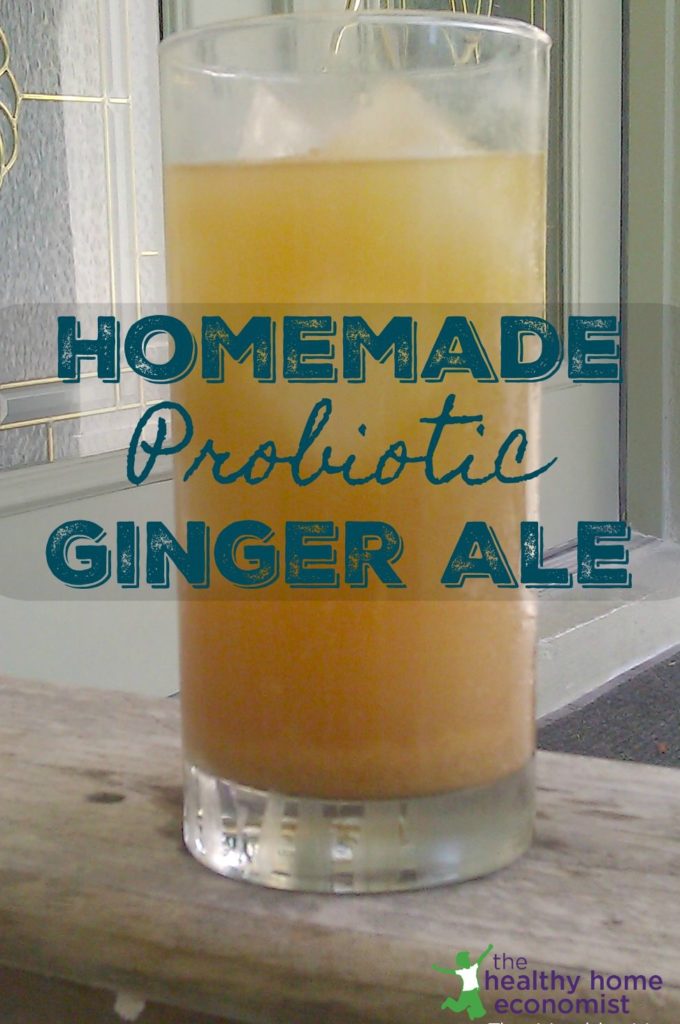Table of Contents[Hide][Show]
A traditional recipe for homemade ginger ale that is lightly fermented with cultured starter, which adds beneficial probiotics and enzymes for digestive benefits as well as delicious taste!

Ginger ale is one of the easiest drinks to whip up at home in a matter of minutes.
The bonus of making ginger ale yourself is that you can ferment it.
This means it is loaded with beneficial bacteria known as probiotics. In addition, traditionally brewed ginger ale is rich in enzymes and has enhanced nutritional value.
Fermentation of grains, fruits and herbs into refreshing and delicious drinks is nearly universal in ethnic cuisines, according to the Nourishing Traditions cookbook, from which this beverage recipe is adapted.
Sadly, the emphasis on convenience in our modern society means that this practice is largely forgotten with the continued popularity of commercial sodas.
Modern versions of ancestral beverages offer no redeeming nutritional benefit.
Worse, the consumption of these sugar-laced or artificially sweetened drinks encourages obesity and other chronic ailments.
Soda really can be healthy! Learning traditional preparation techniques is all that is required.
Preparation Tips
Raw liquid whey is the suggested starter for this beverage and the one I’ve used for decades with great success.
Please refer to this article on the various methods for making raw whey at home for additional details to determine which approach works best for you.
Note that you cannot buy raw whey commercially, although some small dairy farms have it available for purchase.
If a dairy allergy is present, a quarter cup of ginger ale starter or “ginger bug” or water kefir is a simple substitution.
Other ideas for dairy-free fermentation are detailed in the linked article.
While sucanat (pure dried cane juice) is the recommended sweetener, jaggery is a healthy option as well that produces great results.
Raw honey also works for those on gut healing diets such as GAPS. Note that the fermentation will generally occur a bit more quickly using it. I suggest reducing the fermentation time to 1-2 days if using raw honey.
A secondary fermentation using bottles to add additional fizz is optional, but a great idea if you have the time and inclination!

Homemade Ginger Ale Recipe
A traditional recipe for homemade ginger ale that is lightly fermented with cultured starter which adds beneficial probiotics and enzymes to the brew.
Ingredients
- 2 quarts filtered water
- 1/2 cup lime juice freshly squeezed, about 3 limes (preferably organic)
- 2 tsp ground ginger or 2 Tbsp freshly chopped ginger
- 1/3 cup sucanat
- 1 tsp sea salt
- 1/4 cup liquid whey do not use powdered whey
- 1-2 Tbsp raw honey optional
- pinch green stevia powder optional
Instructions
-
Mix all ingredients together thoroughly in a half gallon glass jar. Be sure to leave 1 inch at the top else the soda will get moldy instead of ferment. Affix a secure lid.
-
Leave at room temperature on the counter for 2-3 days and then refrigerate. D not leave near a fruit bowl. Homemade ginger ale is mildly fizzy. You can then mix with sparkling mineral water to add even more fizz if desired.
-
Alternatively, you can bottle the homemade soda and leave on the counter for an additional 1-2 days before refrigerating to produce a very fizzy beverage. Be sure to let the bottled soda get very cold before opening. Opening in the sink is also a good idea.
-
If the finished homemade ginger ale is not sweet enough for your taste (usually necessary for those coming off a soda habit), add a pinch of optional stevia or stir in a small amount of raw honey.

Other Fermented Beverages to Try!








I started ginger ale, but I forgot to put in the fridge before we left town for a fees days. It has been on my counter for 5 days. Is it bad? Do I need to start over?
Will try this soon. On gaps so can’t have whey yet. You say one can use a probiotic capsule. Could I do this for other ferments eg vegetables instead of using whey or doubling the salt? I’ve not heard anyone do this.
Hi Sarah,
I LOVE your website!! I’m just making the ginger ale and realized that I wasn’t sure whether to put the top on the ginger ale while it’s sitting on the counter or do I just put a fabric cloth on top? Will one make it more fizzy? Thanks so much!
What’s “sucanet” and where would I get it?
rapadura is another name for it, or similar type of sugar
Sounds delish!
I make ginger kombucha all the time. That tastes a lot like ginger ale and is the favorite kombucha flavor in my house. Something else to try if you haven’t already.
Hi Sarah:
Any idea if I can do this without the citrus? My dad is on chemo and I’m looking for a recipe that uses probiotics and ginger to help with his stomach, but he cannot have citrus because of the medication he’s on.
Could I substitute another fruit juice or is the citrus necessary?
Thanks so much.
We need more healthy beverage choices! Thanks.
The alcohol is extremely minimal due to the addition of whey and sea salt to the recipe. You can always make some and test it at home if you want to. I believe someone told me that you can buy an alcohol test strip or meter of some kind at the drugstore?
Thanks! We are paleo /dairy and I’ve wanted to try fermented foods but heard that the alcohol content could vary widely by recipe or time left to ferment and I’ve been scared of giving kids with possible genetic alcoholism tendency anything alcoholic. This drink sounds delicious. I love ginger.
Do you know how much alcohol is in this? We have alcoholism in the family, and also I don’t like giving alcohol to kids.